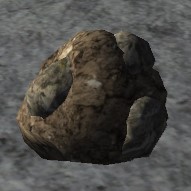Difference between revisions of "Unidentified fragment"
Jump to navigation
Jump to search
Docterchese (talk | contribs) (Add note on output trait causing frags to be picked up) |
|||
| (13 intermediate revisions by 4 users not shown) | |||
| Line 2: | Line 2: | ||
{{itemBox | {{itemBox | ||
|name={{PAGENAME}} | |name={{PAGENAME}} | ||
| − | | | + | |image=Unidentified_fragment.jpg |
|creation=[[Archaeology|Investigate]] | |creation=[[Archaeology|Investigate]] | ||
|result=*'''{{PAGENAME}}''' (1.00 kg) | |result=*'''{{PAGENAME}}''' (1.00 kg) | ||
| − | |improve= | + | |improve=Archaeology}} |
==Description== | ==Description== | ||
| Line 12: | Line 12: | ||
Unidentified fragments are found by [[investigate|investigating]] a tile. | Unidentified fragments are found by [[investigate|investigating]] a tile. | ||
| − | == | + | ==Notes== |
| − | Unidentified fragments can be identified by using a [[stone chisel]] and/or a [[metal brush]]. Activate the tool, right click on the unidentified fragment and select ''Identify''. | + | * Unidentified fragments can be identified by using a [[stone chisel]] and/or a [[metal brush]]. Activate the tool, right click on the unidentified fragment and select ''Identify''. |
| − | *The IDENTIFY action can be [[keybinds|bound]] to a key. | + | * The IDENTIFY action can be [[keybinds|bound]] to a key. |
| − | Once identified, the fragment will state how many other fragments need to be combined in order to create a finished product. | + | * Once identified, the fragment will state how many other fragments need to be combined in order to create a finished product. |
| + | * This uses the [[Archaeology|Restoration]] skill. | ||
| + | * Animals with the [[Animal_husbandry#Traits|"It seems to pick stuff up"]] output trait have a small chance of unearthing fragments while eating. | ||
| − | + | ==Variants== | |
| + | Either upon investigation, or during the restoration process, you may encounter one of the following types of partially identified fragments. | ||
| + | * Unidentified wooden fragment | ||
| + | * Unidentified weapon fragment | ||
| + | * Unidentified tool fragment | ||
| + | * Unidentified metal fragment | ||
| + | * Unidentified container fragment | ||
| + | * Unidentified statue fragment | ||
| + | * Unidentified armour fragment | ||
| − | + | At higher skill levels you may investigate an item of a specific type directly, e.g. an ore fragment or wooden fragment, at any point on the identification spectrum. | |
| − | |||
| − | |||
| − | |||
| − | |||
| − | |||
Latest revision as of 21:07, 5 June 2023
Main / Resources / Unidentified fragment
| Creation |
|---|
| Result |
|
| Skill and improvement |
|
Description
A fragment of another item. You think you can see how multiples of these fragments may fit together in a way that restores the original item. A [metal brush/chisel] would be useful to clear away some dirt and rock from it.
Unidentified fragments are found by investigating a tile.
Notes
- Unidentified fragments can be identified by using a stone chisel and/or a metal brush. Activate the tool, right click on the unidentified fragment and select Identify.
- The IDENTIFY action can be bound to a key.
- Once identified, the fragment will state how many other fragments need to be combined in order to create a finished product.
- This uses the Restoration skill.
- Animals with the "It seems to pick stuff up" output trait have a small chance of unearthing fragments while eating.
Variants
Either upon investigation, or during the restoration process, you may encounter one of the following types of partially identified fragments.
- Unidentified wooden fragment
- Unidentified weapon fragment
- Unidentified tool fragment
- Unidentified metal fragment
- Unidentified container fragment
- Unidentified statue fragment
- Unidentified armour fragment
At higher skill levels you may investigate an item of a specific type directly, e.g. an ore fragment or wooden fragment, at any point on the identification spectrum.
